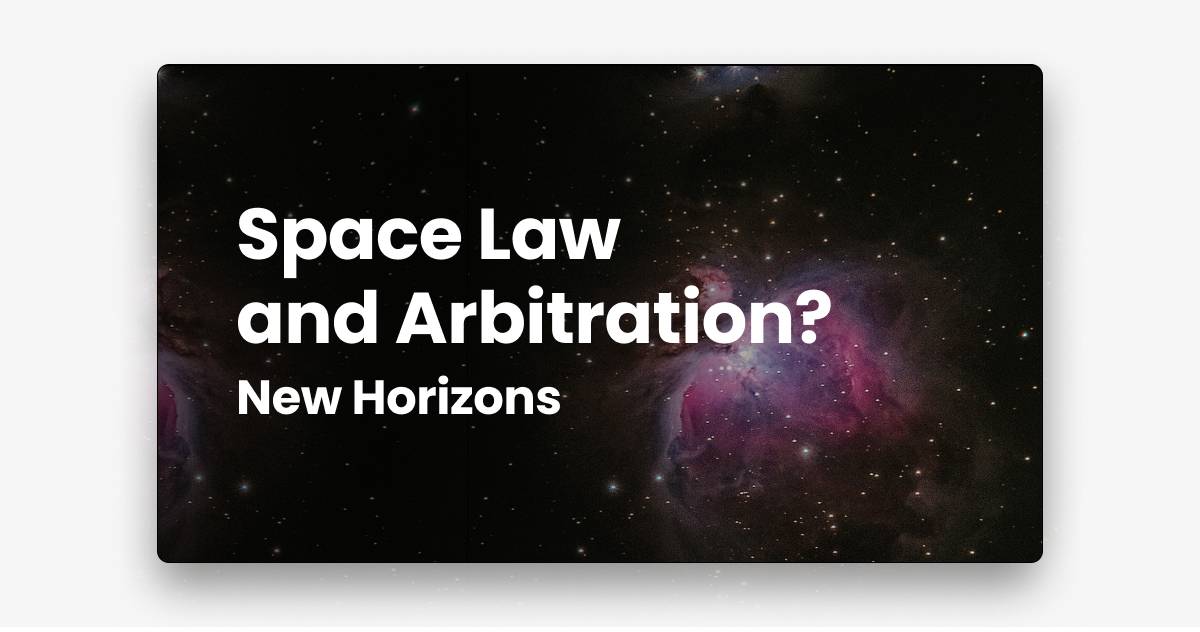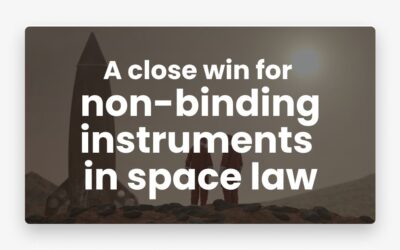
On 29 September 2022, the World Arbitration Update hosted a topical discussion in a realm that is, a priori, intrinsically decentralized: the interconnection between space law and international arbitration. The panel was moderated by Viva Dadwal (King & Spalding), and featured Prof. Irmgard Marboe (University of Vienna, Austria), Werner Eyskens (Crowell Moring LLP, Partner), Dr. Jan Frohloff (Space Arbitration Association), Nick Storrs (Taylor Wessing, Partner) and Maximilian Trautinger (Schonherr).
Laying Down the Space Law Framework
Prof. Irmgard Marboe first introduced the Outer Space Treaty of 1967 (“OST”), which set the general principles governing human activities in outer-space. Based on this first foundational Treaty, four other specialized agreements followed: the Rescue Agreement of 1968 on assistance in the rescue of astronauts (which builds upon OST’s articles 5 and 8), the Liability Convention of 1972 (“LIAB”) concerning damage caused by a State’s space objects on the surface of the Earth or to aircraft, the Registration Convention of 1974(“REG”) which builds upon the previous instruments and aims at identifying space objects, and finally, the Moon Agreement of 1979, which notably provides for the peaceful use of the Moon and “other celestial bodies”.
Prof. Irmgard Marboe stressed that these Treaties lay down four principles relevant to international disputes: responsibility, liability, registration, and the definition of a “launching State“.
The principle of responsibility in space law provides that States are internationally responsible for their national activities, conducted both by national governmental and non-governmental entities, in case of violations of international law (“unlawful acts“). The corollary is that the activities of non-governmental entities in outer space, including the moon and other celestial bodies, shall require authorization and continuing supervision by the appropriate State Party to the Treaty.
The principle of liability in space law provides that States are internationally liable for damages caused by space objects for which they are the “launching State“. Liability is absolute for damage on Earth and aircraft in flight, and based on fault for damage caused in outer space.
The principle of registration in space law provides that States have the obligation to register space objects for which they are the “launching State“. Registration creates a link between a space object and the liable State.
The “launching State” refers to a State which: (1) launches or procures the launching of a space object; or (2) from whose territory or facility a space object is launched.
In terms of procedural aspects, the LIAB includes specific rules on outer-space dispute settlement. These rules provide for the establishment of a Claims Commission. The Claims Commission issues recommendatory awards, which will be final and binding if the parties have so agreed. Outer-space disputes may also be resolved through arbitration. In 2011, the Permanent Court of Arbitration published optional rules for arbitrating disputes relating to outer space activities, based on the UNCITRAL Arbitration Rules.
Arbitration as an Efficient Mean to Settle Space Disputes
Werner Eyskens recalled that space is an expanding market, increasingly dominated by private players, and subject to significant constraints. Werner Eyskens contends that, for three reasons, such a market will generate numerous disputes.
First, the scarcity of resources and the multiplication of incidents. Second, the multiplication of private players with short-term economic objectives, which will resort to arbitration to translate potential losses in financial compensation. Third, space activities cover many technical areas that can generate disputes regarding frequency spectrum, environment, tourism, etc.
Werner Eyskens observed that arbitration may be the most appropriate way to settle these disputes, because of the advantages it offers over State courts:
- an independent forum;
- the possibility to choose the language of the proceedings and to designate specialized arbitrators;
- confidentiality;
- a controlled document production process; and
- the opportunity for parties to bring forward their own experts.
The Specific Features of Space Arbitration
Dr. Jan Frohloff, editor-in-chief of the Space Arbitration Blog, stressed that space arbitration presents three features. First, space disputes can become political, since satellites and rockets are dual-use goods, and because some of the key players in the industry are still space agencies. An example can be found in the Antrix v. Devas saga, where the Indian state-owned company Antrix had leased S-band satellite spectrum to Devas. Five years after the deal was signed, the Devas-Antrix agreement had become mired in controversy, with allegations of corruption, and the government rescinded the contract with Devas.
Second, space activities largely involve public law issues: the selling of satellites abroad requires export-control permits, and the operating of a satellite in orbit requires the right to use the frequency in the relevant orbit. These public law issues regularly find their way to space arbitration. For example, in ABSH v. KT and KTSAT, the arbitral tribunal had to decide whether title to a geostationary satellite had passed from the Korean seller of the satellite (KT) to the foreign buyer (ABS); after Korea’s Ministry of Science issued an order that declared the purchase agreement “null and void” and since KT had allegedly failed to obtain a Korean export permit.
Third, Dr. Jan Frohloff recalled that due to the nature of this industry, space arbitrations are most often confidential: there are therefore few sentences publicly available in this area.
The Impact of Space Debris in the Industry
Nick Storrs observed that “space debris” represent a near-term existential threat to the space industry itself, which therefore has a strong interest in ensuring that this matter is managed. He recalled that damages caused by objects in outer space are principally governed by the LIAB. This liability regime requires to identify (1) to which State the particular debris belong and (2) whether there is a fault. Both of these elements are difficult to determine in practice.
For now, the issue of space debris is largely managed through inter-agency cooperation, like the Inter-Agency Space Debris Coordination Committee, whose Guidelines on Space Debris Mitigation provide a cooperation framework by setting basic standards and objectives.
Space debris management is therefore self-regulated, without an enforcement mechanism. Nick Storrs anticipated that enforceable commitments will become necessary as the industry grows and space debris multiply. Arbitration may have a role in such commitments. Nick Storrs drew a parallel with environmental issues where, in spite of the difficulty of attributing liability, international agreements have defined common standards and have included arbitration as a means of dispute resolution.
The Allocation of Space Resources
Maximilian Trautinger highlighted the issue of the allocation of space resources. In particular, geostationary orbital positions (“GEO”) are a limited resource, and were first allocated through a first come first served approach. In 1977, the International Telecommunication Union (“ITU”) adopted an allotment plan for GEO. For other orbital positions than GEOs, such as the Low Earth Orbit (“LEO”), the first come first served approach still prevails.
The same applies to the use of the radio frequencies, which are also limited resources. While the allotment of radio frequencies in GEOs is managed by the ITU, radio frequencies in other orbits are allocated on a first come first served basis.
The question of resource ownership will therefore become even more pressing in the future. Maximilian Trautinger recalled that the principle of non-appropriation set out in the Outer Space Treaty and the Moon Treaty provides that outer space and celestial bodies are not subject to appropriation.
However, in 2015, the U.S. adopted the SPACE Act allowing US citizens and industries to engage in the commercial exploration and exploitation of space resources. Similar regulations were passed in Luxembourg and Japan, suggesting that the issue of space resources ownership will become an important source of disputes in the future.
Maximilian Trautinger also pointed out the potential conflicts that could arise from (1) the delivery of critical materials based on complex supply chains and (2) the growth of private investments in space, increasingly exposing investors to the risks of this industry.
New Horizons
According to Maximilian Trautinger’s words, we are entering a period of growing frictions in a frictionless space. The principles set out in the existing international legal instruments, established at a time when States were the main players in space exploration, are effectively being challenged. These frictions concern, first of all, the rise of private actors, with their own interests, alongside the States. These frictions are also caused by some States themselves, when they grant their nationals certain rights in contradiction with the principle of non-appropriation. Lastly, these frictions are also due to the intensification of space activities and their consequences, e.g., the multiplication of debris.
These frictions will inexorably give rise to disputes, between different actors, and regarding various issues. Because of its flexibility and efficiency, arbitration appears perfectly suited to the resolution of these disputes. If it already plays a role today, its wider use will however depend on the adoption of binding international agreements.
This contribution was first published by Jus Mundi on 2 November 2022.
You might also like
Investment Protection and Space Investors
Investment Protection and Space Investors By Luca Erhart and Riccardo LoschiInvestment Protection...
A close win for non-binding instruments in space law
A close win for non-binding instruments in space law By Ruvimbo Samanga"A close win for...
Space Arbitration: Protecting Space Investments
Space Arbitration: Protecting Space Investments By Katie MakSpace Arbitration: Protecting Space...


